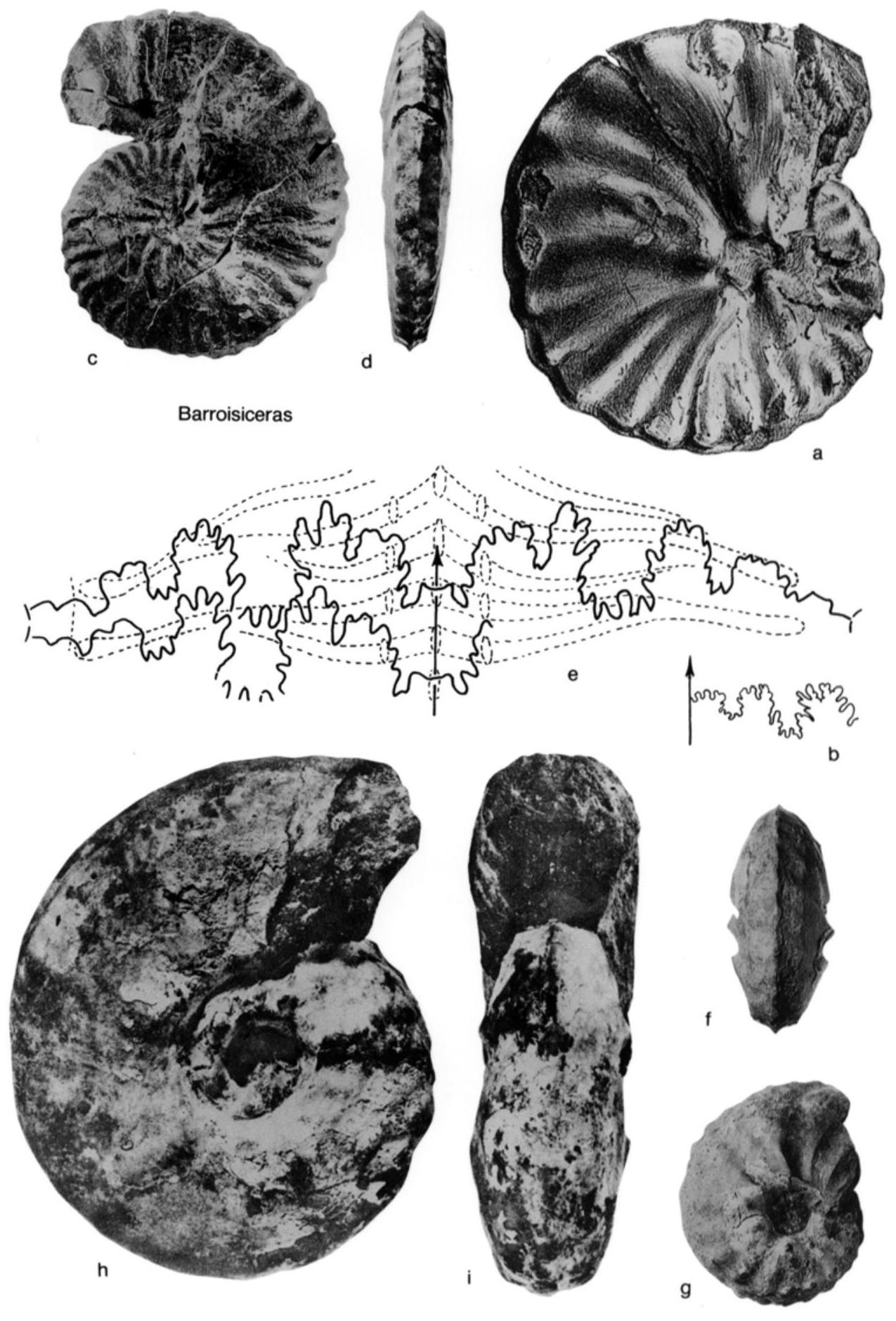Welcome to the Treatise on Invertebrate Paleontology!
Please enter a genera name to retrieve more information.

Barroisiceras
Classification
Phylum:
Mollusca
Class:
Cephalopoda
Subclass:
Ammonoidea
Order:
Ammonitida
Suborder:
Ammonitina
Superfamily:
Acanthocerataceae
Family:
Collignoniceratidae
Subfamily:
Barroisiceratinae
Formal Genus Name and Reference:
Barroisiceras Grossouvre, 1894, p. 50, nom. nov. pro Barroisia Grossouvre, 1894, p. 50, non MUNIER-CHALMAS, 1882, p. 425
Type Species:
Ammonites haberfellneri Hauer, 1866, p. 301, SD SOLGER, 1904, p. 163
Images
(Click to enlarge in a new window)
Fig. 144a, b. *B. haberfellneri (Hauer), ?Upper Turonian, Austria, X1 (Redtenbacher, 1873)., Fig. 144c, d. B. minimum Hayasaka & Fukada, Upper Turonian, Japan, X0.5, Fig. 144e. B. minimum Hayasaka & Fukada, Upper Turonian, Japan, X2.5, Fig. 144f, g. B. mahafalense (BASSE), Lower Coniacian, Madagascar, X0.4, Fig. 144h, i. B. colnacapi (Collignon), Lower Coniacian, Madagascar, X0.75
Synonyms
Subbarroisiceras; Reesidites; Basseoceras; Itwebeoceras; Buenoceras
Geographic Distribution
England, Spain, Germany, Austria, northern and western Africa, South Africa (Zululand), Madagascar, Armenia, Japan, Texas, Venezuela, Colombia, Peru
Age Range
Beginning Stage in Treatise Usage:
Upper Cretaceous (Upper Turonian)
Beginning International Stage:
Turonian
Fraction Up In Beginning Stage:
75
Beginning Date:
90.52
Ending Stage in Treatise Usage:
Upper Cretaceous (Lower Coniacian)
Ending International Stage:
Coniacian
Fraction Up In Ending Stage:
50
Ending Date:
87.55
Description
Rather involute to rather evolute, compressed to moderately inflated, high-whorled, with flat to slightly convex sides and fastigiate venter, dense to sparse, bullate to spinate umbilical tubercles giving rise to 2 or 3 straight to slightly sinuous, narrow to broad ribs, additional ribs may be intercalated, each rib bearing a distinct ventrolateral and siphonal clavus, ornament weakening on body chamber and may disappear except for fine striae and traces of siphonal tubercles. Primitive forms (e.g., B. minimus) differ from Subprionocyclus only in the absence of inner ventrolateral tubercles at any stage.
References
Museum or Author Information
Classification
Phylum:
Mollusca
Class:
Cephalopoda
Subclass:
Ammonoidea
Order:
Ammonitida
Suborder:
Ammonitina
Superfamily:
Acanthocerataceae
Family:
Collignoniceratidae
Subfamily:
Barroisiceratinae
Formal Genus Name and Reference:
Barroisiceras Grossouvre, 1894, p. 50, nom. nov. pro Barroisia Grossouvre, 1894, p. 50, non MUNIER-CHALMAS, 1882, p. 425
Type Species:
Ammonites haberfellneri Hauer, 1866, p. 301, SD SOLGER, 1904, p. 163
Images
(Click to enlarge in a new window)
Fig. 144a, b. *B. haberfellneri (Hauer), ?Upper Turonian, Austria, X1 (Redtenbacher, 1873)., Fig. 144c, d. B. minimum Hayasaka & Fukada, Upper Turonian, Japan, X0.5, Fig. 144e. B. minimum Hayasaka & Fukada, Upper Turonian, Japan, X2.5, Fig. 144f, g. B. mahafalense (BASSE), Lower Coniacian, Madagascar, X0.4, Fig. 144h, i. B. colnacapi (Collignon), Lower Coniacian, Madagascar, X0.75
Synonyms
Subbarroisiceras; Reesidites; Basseoceras; Itwebeoceras; Buenoceras
Geographic Distribution
England, Spain, Germany, Austria, northern and western Africa, South Africa (Zululand), Madagascar, Armenia, Japan, Texas, Venezuela, Colombia, Peru
Age Range
Beginning Stage in Treatise Usage:
Upper Cretaceous (Upper Turonian)
Beginning International Stage:
Turonian
Fraction Up In Beginning Stage:
75
Beginning Date:
90.52
Ending Stage in Treatise Usage:
Upper Cretaceous (Lower Coniacian)
Ending International Stage:
Coniacian
Fraction Up In Ending Stage:
50
Ending Date:
87.55
Description
Rather involute to rather evolute, compressed to moderately inflated, high-whorled, with flat to slightly convex sides and fastigiate venter, dense to sparse, bullate to spinate umbilical tubercles giving rise to 2 or 3 straight to slightly sinuous, narrow to broad ribs, additional ribs may be intercalated, each rib bearing a distinct ventrolateral and siphonal clavus, ornament weakening on body chamber and may disappear except for fine striae and traces of siphonal tubercles. Primitive forms (e.g., B. minimus) differ from Subprionocyclus only in the absence of inner ventrolateral tubercles at any stage.
